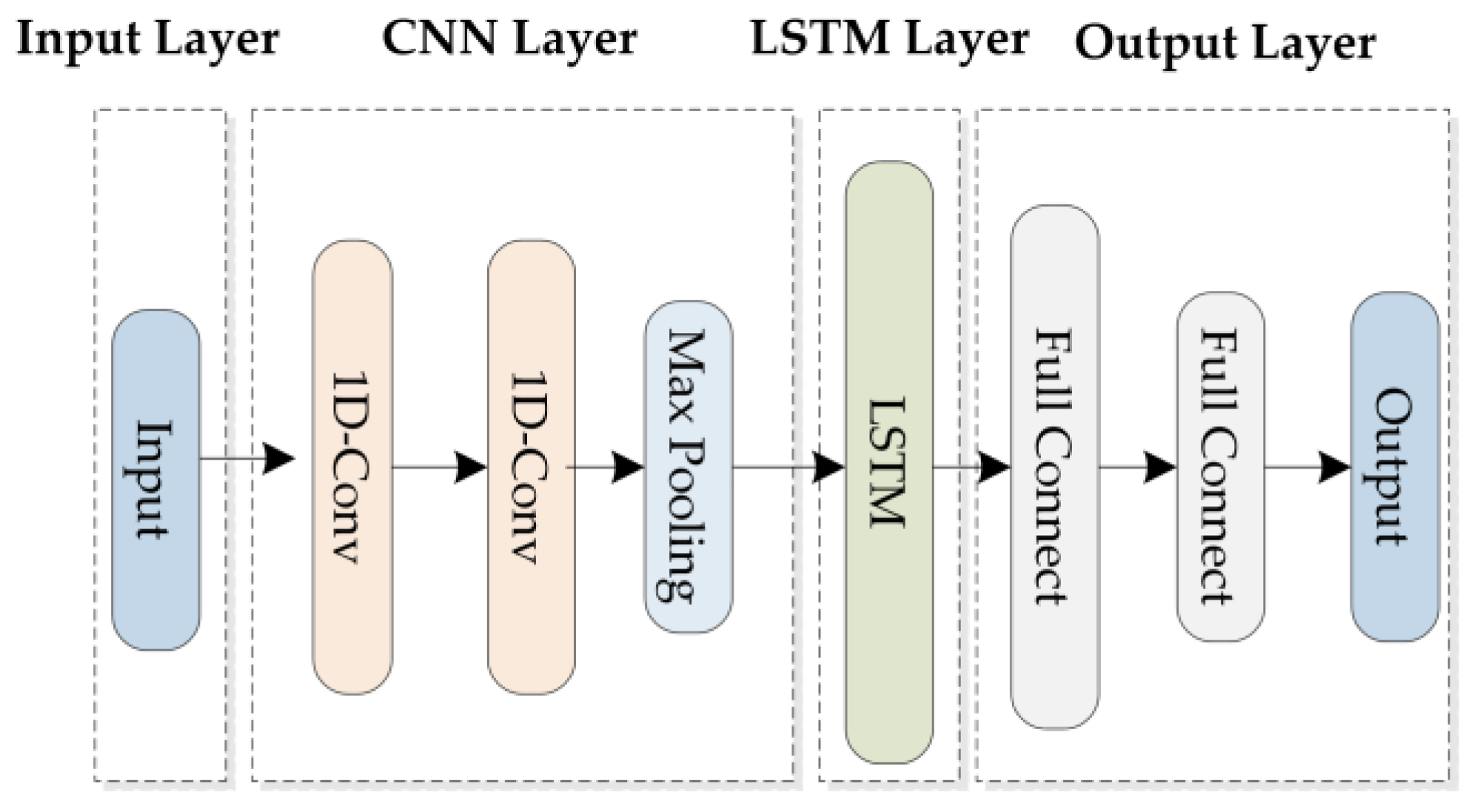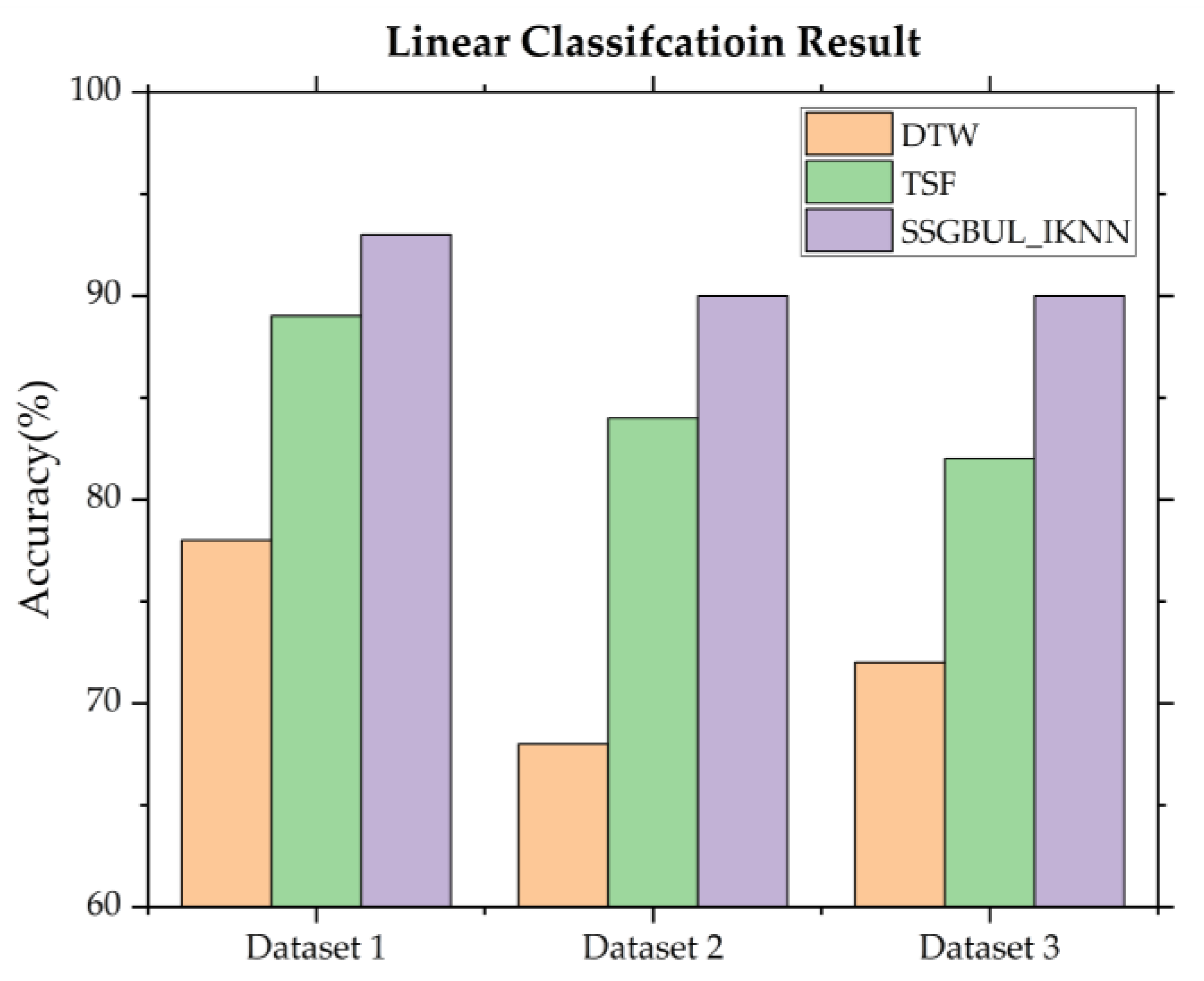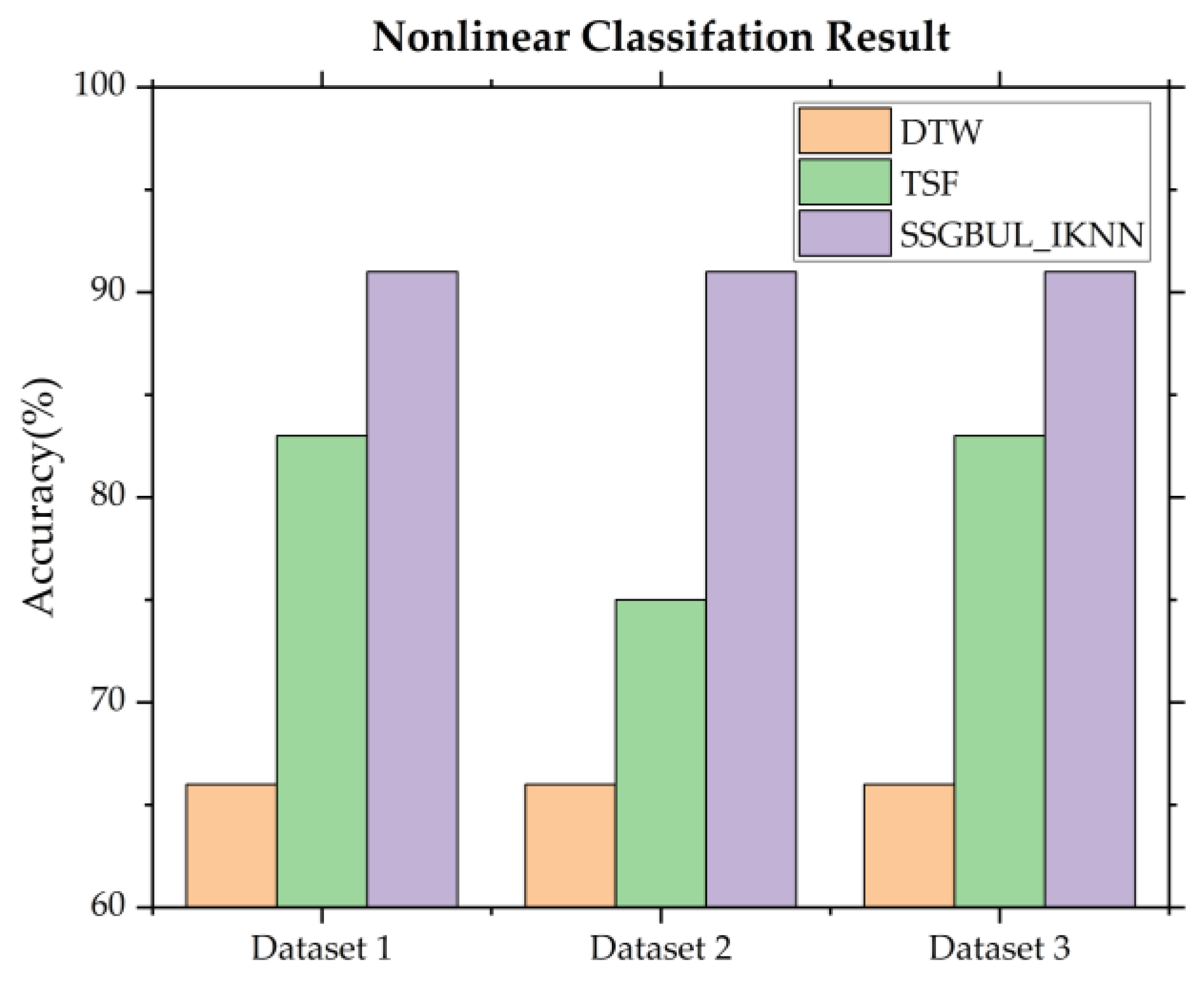Research on Fault Detection by Flow Sequence for Industrial Internet of Things in Sewage Treatment Plant Case
Abstract
1. Introduction
- We designed a code generator model, SSGBUL, to encode flow value and utilized the subsequence calibration function to reduce the prediction error during the encoding process.
- We identified the detail fault type by encoding the flow sequence. Firstly, we redefined the fault type tables by encoding sequences. And then, we converted the multi-dimensional flow sequences into one integrated code sequence. Finally, we identified the fault type using the integrated sequence and compared it with the encoding fault types.
2. SSGBUL–IESC Algorithm
2.1. SSGBUL Model
2.1.1. NFPBUL Prediction Model
2.1.2. Coding Model
2.1.3. Subsequence Calibration
- (1)
- Calculate the fixed position flow threshold value in a single data cycle on the training dataset according to Equation (10). Firstly, calculate the maximum network flow at each position. Then, subtract the average network flow to determine the error value according to Equation (10):where is the flow value at a fixed position within the data circle.
- (2)
- Select the maximum threshold value as the whole sequence threshold according to Equation (11):where is the threshold at a fixed position within the data circle.
- (3)
- Calibrate the network flow. If the sequence is too regular, we can add a fixed value to ε prevent the model becoming too sensitive. Based on the difference between the actual value and predicted value, dynamically adjust the sequence item according to Equation (12). If the absolute difference value is greater than the threshold ε, it means that the actual value is abnormal, and construct the network flow subsequence with the predicted value. Otherwise, construct the network flow subsequence with the actual value according to Equation (12):where is the reconstructed network flow value at time t.
- (4)
- (5)
- Generate the network flow code sequence according to Equation (8).
- (6)
- Repeat steps 3 to 5 to generate the final code sequence after multiple rounds of prediction and encoding.
2.2. Classification Algorithm
2.2.1. Integrated Module
2.2.2. Encoding Fault Definition
2.2.3. IESC Classification Algorithm
| Algorithm 1. IESC Algorithm. |
| 1: Input: integrated encoding sequence 2: Output: fault type 3: Start: 4: 5: function compareSequence (sourceSequence, targetSequence) 6: flag ← 1 7: for i = 1: sourceSequence.length do 8: if sourceSequence[i] != targetSequence[i] then 9: flag = 0 10: break 11: end if 12: end for 13: return flag 14: end function 15: 16: function IESC (inputEncodingSequence) 17: faultType ← −1 18: for i = 1: faultList.size do 19: if compareSequence (inputEncodingSequence, faultList[i]) == 0 then 20: faultType = i 21: break 22: end if 23: end for 24: end function 25: End |
3. Data Acquisition
3.1. IIoT Architecture of Sewage Treatment Plant
3.2. Network Flow Collection Model
3.3. Sensor Network
4. Experimental Results
4.1. Dataset Introduction
4.2. Typical Abnormal Sequence
- Sensor disconnection. Sensor data are always sent to cloud servers in MQTT format. The content of MQTT includes data name and data value. Data value is obtained by converting different types of sensor values into character types, such as long, double, int, and so on. When this fault happens, the sensor data will become 0. So, the length of the converted MQTT transmission packet will be smaller than normal. And that will lead to the send flow amount of the network card PPP0 to decrease. Figure 7 shows the network flow diagram of sensor disconnection.
- Remote I/O offline. When this fault occurs, the IIoT gateway cannot collect sensor information connected to this remote I/O unit. So, the received network flow of the Eth0 will be decreased. Figure 8 shows the network flow diagram of the remote I/O offline fault.
4.3. Experimental Metric
4.4. Ablation Experiment
4.5. Compare Experimental Results
4.5.1. Linear Subsequences Classification
4.5.2. Nonlinear Subsequences Classification
4.5.3. Different Subsequence Length Results
5. Discussion
6. Conclusions
- We designed a code generator model, SSGBUL, to translate the flow value to the unified code value and utilized the subsequence calibration function to reduce errors during the encoding process.
- We identified the detail fault type by encoding sequence type. Firstly, we redefined the fault type tables by encoding sequences. And then, we converted the multi-dimensional flow sequences into one integrated code sequence representing the operational status of the IIoT gateway. Finally, we identified the fault type by the integrated sequence by comparing it with the elements in the redefined fault type tables.
Author Contributions
Funding
Institutional Review Board Statement
Informed Consent Statement
Data Availability Statement
Conflicts of Interest
References
- Huo, R.; Zeng, S.; Wang, Z.; Shang, J.; Chen, W.; Huang, T.; Wang, S.; Yu, F.R.; Liu, Y. A comprehensive survey on blockchain in industrial internet of things: Motivations, research progresses, and future challenges. IEEE Commun. Surv. Tutor. 2022, 24, 88–122. [Google Scholar] [CrossRef]
- Rahman, M.S.; Ghosh, T.; Aurna, N.F.; Kaiser, M.S.; Anannya, M.; Hosen, A.S. Machine learning and internet of things in industry 4.0: A review. Meas. Sens. 2023, 28, 100822. [Google Scholar] [CrossRef]
- Kannamma, R.; Umadevi, K.S. Neuro-Fuzzy-Based Frame Pre-Emption Using Time-Sensitive Networking for Industrial Ethernet. J. Inf. Knowl. Manag. 2021, 20, 2140008. [Google Scholar] [CrossRef]
- Juma, M.; Monem, A.A.; Shaalan, K. Hybrid End-to-End VPN Security Approach for Smart IoT Objects. J. Netw. Comput. Appl. 2020, 158, 102598. [Google Scholar] [CrossRef]
- Zhou, X.; Liang, W.; Li, W.; Yan, K.; Shimizu, S.; Wang, K.I.-K. Hierarchical Adversarial Attacks Against Graph-Neural-Network-Based IoT Network Intrusion Detection System. IEEE Internet Things J. 2022, 9, 9310–9319. [Google Scholar] [CrossRef]
- Pasyuk, A.; Semenov, E.; Tyuhtyaev, D. Feature Selection in the Classification of Network Traffic Flows. In Proceedings of the 2019 International Multi-Conference on Industrial Engineering and Modern Technologies (FarEastCon), Vladivostok, Russia, 1–4 October 2019; pp. 1–5. [Google Scholar] [CrossRef]
- Santo, Y.; Immich, R.; Dalmazo, B.L.; Riker, A. Fault Detection on the Edge and Adaptive Communication for State of Alert in Industrial Internet of Things. Sensors 2023, 23, 3544. [Google Scholar] [CrossRef] [PubMed]
- Garcés-Jiménez, A.; Rodrigues, A.; Gómez-Pulido, J.M.; Raposo, D.; Gómez-Pulido, J.A.; Silva, J.S.; Boavida, F. Industrial Internet of Things embedded devices fault detection and classification. A case study. Internet Things 2024, 25, 25101042. [Google Scholar] [CrossRef]
- Jammalamadaka, S.K.; Chokara, B.; Jammalamadaka, S.B.; Duvvuri, B.K.; Budaraju, R. Enhancing the Fault Tolerance of a Multi-Layered IoT Network through Rectangular and Interstitial Mesh in the Gateway Layer. J. Sens. Actuator Netw. 2023, 12, 76. [Google Scholar] [CrossRef]
- Liu, Q.; Wang, C.; Wang, Q. Bayesian Uncertainty Inferencing for Fault Diagnosis of Intelligent Instruments in IoT Systems. Appl. Sci. 2023, 13, 5380. [Google Scholar] [CrossRef]
- Bagnall, A.; Lines, J.; Bostrom, A.; Large, J.; Keogh, E. The great time series classification bake off: A review and experimental evaluation of recent algorithmic advances. Data Min. Knowl. Discov. 2017, 31, 606–660. [Google Scholar] [CrossRef]
- Deng, H.; Runger, G.; Tuv, E.; Vladimir, M. A time series forest for classification and feature extraction. Inf. Sci. 2013, 239, 142–153. [Google Scholar] [CrossRef]
- Lines, J.; Taylor, S.; Bagnall, A. Time series classification with HIVE-COTE: The hierarchical vote collective of transformation-based ensembles. ACM Trans. Knowl. Discov. Data 2018, 12, 1–35. [Google Scholar] [CrossRef]
- Middlehurst, M.; Large, J.; Bagnall, A. The canonical interval forest (CIF) classifier for time series classification. In Proceedings of the 2020 IEEE International Conference on Big Data, Atlanta, GA, USA, 10–13 December 2020. [Google Scholar]
- Lin, J.; Khade, R.; Li, Y. Rotation-invariant similarity in time series using bag-of-patterns representation. J. Intell. Inf. Syst. 2012, 39, 287–315. [Google Scholar] [CrossRef]
- Lucas, S.; Portillo, E. Methodology based on spiking neural networks for univariate time-series forecasting. Neural Netw. 2024, 173, 106171. [Google Scholar] [CrossRef]
- He, K.; Fan, H.; Wu, Y.; Xie, S.; Girshick, R. Momentum contrast for unsupervised visual representation learning. In Proceedings of the IEEE/CVF Conference on Computer Vision and Pattern Recognition, Seattle, WA, USA, 13–19 June 2020; pp. 9729–9738. [Google Scholar]
- Wang, Z.; Yan, W.; Oates, T. Time series classification from scratch with deep neural networks: A strong baseline. In Proceedings of the 2017 International Joint Conference on Neural Networks, Anchorage, AK, USA, 14–19 May 2017; pp. 1578–1585. [Google Scholar]
- Fawaz, H.I.; Forestier, G.; Weber, J.; Idoumghar, L.; Muller, P.-A. Deep learning for time series classification: A review. Data Min. Knowl.Discov. 2019, 33, 917–963. [Google Scholar] [CrossRef]
- Cai, Z.; Shu, Y.; Su, X.; Guo, L.; Ding, Z. A traffic data interpolation method for IoT sensors based on spatio-temporal dependence. Internet Things 2023, 21, 100648. [Google Scholar] [CrossRef]
- Bandy, A.D.; Spyridis, Y.; Villarini, B.; Argyriou, V. Intraclass Clustering-Based CNN Approach for Detection of Malignant Melanoma. Sensors 2023, 23, 926. [Google Scholar] [CrossRef]
- Zaheer, S.; Anjum, N.; Hussain, S.; Algarni, A.D.; Iqbal, J.; Bourouis, S.; Ullah, S.S. A Multi Parameter Forecasting for Stock Time Series Data Using LSTM and Deep Learning Model. Mathematics 2023, 11, 590. [Google Scholar] [CrossRef]
- Saharkhizan, M.; Azmoodeh, A.; Dehghantanha, A.; Choo, K.-K.R.; Parizi, R.M. An ensemble of deep recurrent neural networks for detecting IoT cyber attacks using network traffic. IEEE Internet Things J. 2020, 7, 8852–8859. [Google Scholar] [CrossRef]
- Cheng, X.; Zhang, W.; Wenzel, A.; Chen, J. Stacked ResNet-LSTM and CORAL model for multi-site air quality prediction. Neural Comput.Appl. 2022, 34, 13849–13866. [Google Scholar] [CrossRef]
- Alaghbari, K.A.; Lim, H.S.; Saad, M.H.; Yong, Y.S. Deep Autoencoder-Based Integrated Model for Anomaly Detection and Efficient Feature Extraction in IoT Networks. IoT 2023, 4, 345–365. [Google Scholar] [CrossRef]
- Kumar, B.P.; Hariharan, K.; Shanmugam, R.; Shriram, S.; Sridhar, J. Enabling internet of things in road traffic forecasting with deep learning models. J. Intell. Fuzzy Syst. 2022, 43, 6265–6276. [Google Scholar] [CrossRef]
- Zhao, N.; Sun, H.; Li, Q.; Huang, O. Time series prediction model mWDLNet based on wavelet decomposition and its application research. Small scale microcomputer system. J. Chin. Comput. Syst. 2022, 43, 561–567. [Google Scholar] [CrossRef]
- Zhao, J.; Li, J.; Long, C.; Wan, W.; Wei, J.; Chen, K. Unsupervised detection method for RoQ covert attacks based on multi-level features. J. Commun. 2022, 43, 224–239. [Google Scholar]
- Jingyi, R.; Huijuan, H.; Wenyue, X. Big data intelligent tourism management platform design based on abnormal behavior identification. Intell. Syst. Appl. 2024, 21, 21200312. [Google Scholar]
- Huang, J.; Xu, X.; Cui, X.; Kang, J.; Yang, H. A Time Series Symbolic Aggregation Approximation Method for Fusion of Trend Information. Comput. Appl. Res. 2023, 40, 86–90. [Google Scholar] [CrossRef]
- Lu, Y.; Wang, P.; Wang, W. Time series semantic mining algorithm based on subsequence similarity. Comput. Eng. 2022, 48, 88–94. [Google Scholar] [CrossRef]
- Mahsa, H.; Abbas, M.; Reza, G. Stacking: A novel data-driven ensemble machine learning strategy for prediction and mapping of Pb-Zn prospectivity in Varcheh district, west Iran. Expert Syst. Appl. 2024, 237, 121668. [Google Scholar]
- Pino, A.F.; Ruiz, P.H.; Mon, A.; Collazos, C.A. Systematic literature review on mechanisms to measure the technological maturity of the Internet of Things in enterprises. Internet Things 2024, 25, 25101082. [Google Scholar] [CrossRef]
- I/O Module Enables Remote Data Capture. NASA Tech. Briefs 2021, 45, 49.
- Banner Engineering Corp. Modbus System Having Actual and Virtual Slave Addresses and Slave Sensors. U.S. Patent 10,805,262, 13 October 2020.
- Stój, J.; Kampen, A.-L.; Cupek, R.; Smołka, I.; Drewniak, M. Industrial Shared Wireless Communication Systems—Use Case of Autonomous Guided Vehicles with Collaborative Robot. Sensors 2023, 23, 158. [Google Scholar] [CrossRef] [PubMed]
- Miloch, S.; Kińczyk, W.; Mohamed-Seghir, M. Use of Modbus RTU, Profibus DP and HTTP Protocol for AC Motor Control. Int. J. Innov. Technol. Explor. Eng. (IJITEE) 2022, 12, 93681212122. [Google Scholar] [CrossRef]
- Chen, Y.H.; Zhang, D.Y.; Ji, J.; Chen, X. Design of PROFINET I/O Real-time Communication System between PLC Based on S7-1200. J. Phys. Conf. Ser. 2023, 2569, 012013. [Google Scholar] [CrossRef]
- Tiago, M.; Garcia, V.S.O. Enhanced Modbus/TCP Security Protocol: Authentication and Authorization Functions Supported. Sensors 2022, 22, 8024. [Google Scholar] [CrossRef] [PubMed]
- Hojjati, H.; Ho KK, T.; Armanfard, N. Self-supervised anomaly detection in computer vision and beyond: A survey and outlook. Neural Netw. 2024, 172, 172106106. [Google Scholar] [CrossRef] [PubMed]
- Cho, A.; Kim, T.; Kim, C.K.; Choi, S.; Lee, S. IoT data dissemination scheme for reducing delay in multi-broker environments. Internet Things 2024, 25, 101025. [Google Scholar] [CrossRef]
- Comte, A.; Tricou, T.; Tannier, E.; Joseph, J.; Siberchicot, A.; Penel, S.; Allio, R.; Delsuc, F.; Dray, S.; de Vienne, D.M. PhylteR: Efficient identification of outlier sequences in phylogenomic datasets. Mol. Biol. Evol. 2023, 40, msad234. [Google Scholar] [CrossRef]












| No. | Type | Trend Diagram |
|---|---|---|
| 0 | Normal |  |
| 1 | Sensor disconnected start |  |
| 2 | Sensor disconnected |  |
| 3 | Sensor disconnected end |  |
| 4 | Remote I/O fault start |  |
| 5 | Remote I/O fault |  |
| 6 | Remote I/O fault end |  |
| 7 | Illegal system access start |  |
| 8 | Illegal system access |  |
| 9 | Illegal system access end |  |
| 10 | Cyber-attacks start |  |
| 11 | Cyber-attacks |  |
| 12 | Cyber-attacks end |  |
| Gateway | Remote I/O Amount | Sensor Amount | Sensor Type |
|---|---|---|---|
| 1 | 5 | 100 | water level meter, frequency converter, water pump |
| 2 | 3 | 55 | pH concentration meter, flow meter, frequency converter, water pump |
| 3 | 3 | 35 | CO meter, CO2 meter, blower fan |
| Fault Type | Dataset1 | Dataset2 | Dataset3 |
|---|---|---|---|
| Sensor disconnected | 54 | 54 | 27 |
| Remote I/O fault | 54 | 66 | 81 |
| Illegal system access | 15 | 27 | 27 |
| Cyber-attacks | 15 | 27 | 15 |
| Total | 138 | 174 | 150 |
| Subsequence Length | Dataset1 | Dataset2 | Dataset3 |
|---|---|---|---|
| 5 | 96.42 | 92.96 | 94.41 |
| 10 | 92.75 | 90.22 | 91.66 |
| 20 | 93.58 | 83.00 | 81.11 |
Disclaimer/Publisher’s Note: The statements, opinions and data contained in all publications are solely those of the individual author(s) and contributor(s) and not of MDPI and/or the editor(s). MDPI and/or the editor(s) disclaim responsibility for any injury to people or property resulting from any ideas, methods, instructions or products referred to in the content. |
© 2024 by the authors. Licensee MDPI, Basel, Switzerland. This article is an open access article distributed under the terms and conditions of the Creative Commons Attribution (CC BY) license (https://creativecommons.org/licenses/by/4.0/).
Share and Cite
Lei, D.; Zhao, L.; Chen, D. Research on Fault Detection by Flow Sequence for Industrial Internet of Things in Sewage Treatment Plant Case. Sensors 2024, 24, 2210. https://doi.org/10.3390/s24072210
Lei D, Zhao L, Chen D. Research on Fault Detection by Flow Sequence for Industrial Internet of Things in Sewage Treatment Plant Case. Sensors. 2024; 24(7):2210. https://doi.org/10.3390/s24072210
Chicago/Turabian StyleLei, Dongfeng, Liang Zhao, and Dengfeng Chen. 2024. "Research on Fault Detection by Flow Sequence for Industrial Internet of Things in Sewage Treatment Plant Case" Sensors 24, no. 7: 2210. https://doi.org/10.3390/s24072210
APA StyleLei, D., Zhao, L., & Chen, D. (2024). Research on Fault Detection by Flow Sequence for Industrial Internet of Things in Sewage Treatment Plant Case. Sensors, 24(7), 2210. https://doi.org/10.3390/s24072210





